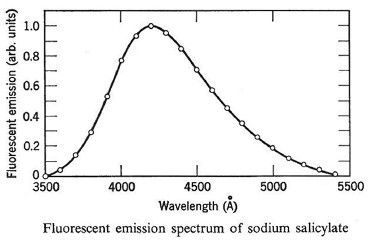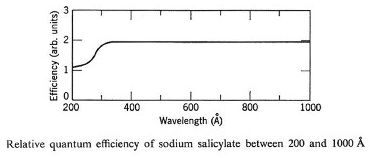Scintillator for VUV Detection
Photomultipliers offer high gain, low noise and fast time response. They are among, if not the most popular and widely used detectors for spectroscopy. It makes sense then, to detect vacuum ultraviolet radiation with a photomultiplier tube. But photomultiplier tubes cannot detect very short wavelengths by themselves. Their glass or quartz enclosure limits the response range. Addition of a scintillator is one method to easily sensitize a PMT for shorter wavelengths (to at least 30nm).
Sodium salicylate is the most popular scintillator we use today. Sodium salicylate has excellent fluorescent efficiency, nearly constant response in the 30 to 300nm spectral region, is easy to prepare, and does not affect vacuum pressure. Stability of fluorescence efficiency is excellent over time in vacuum systems with clean dry vacuum pumps. We have systems in the field using it for more than twenty years with continued good operation. It is our first choice for preparing photomultipliers for spectroscopy in the vacuum ultraviolet.


See also the PDF Sheet for the scintillator and stock coated windows
The coated sodium salicylate layer is mechanically fragile. Do not touch or contact it in any way. Sodium salicylate dissolves readily. Do not wipe or splash any liquid near the coated layer. Mechanical or liquid contact will likely ruin the scintillator coating.
Relative QE and Emission traces from:
Techniques of Vacuum Ultraviolet Spectroscopy, by J.A.R. Samson, Pied Publications 1927 South 26 Street, Lincoln Nebraska
This book is out of print and may be available at a used bookseller. The newer expanded paperback edition may be easier to find:
Vacuum Ultraviolet Spectroscopy / Edition 1 by James A. Samson and David L. Ederer
You might also like:
Relative fluorescent efficiency of sodium salicylate between 90 and 800 eV
The relative fluorescent quantum efficiency of sodium salicylate was measured between 90 and 800 eV (138-15 A) by the use of synchrotron radiation. A general increase in efficiency was observed in this spectral range except for abrupt decreases in efficiency at the carbon and oxygen K-edges. Beyond the oxygen K-edge (532 eV) the efficiency increased linearly with the incident photon energy to the limit of the present observations.
G. C. Angel, James A. R. Samson, and G. Williams
Fluorescent efficiency of sodium salicylate between 116 and 600 Å
Sodium salicylate has been used extensively as a wavelength converter in the vacuum ultraviolet (vuv) spectral region. When excited by radiant energy of wavelengths shorter than about 3500 Å, salicylate fluoresces in a band that covers the range 3500-5500 Å. The usefulness of sodium salicylate results from its relatively constant quantum efficiency over an extremely large wavelength range. The quantum efficiency is defined here as the number of fluorescent photons produced per exciting photon incident on the salicylate. The absolute value of the efficiency is not as important in this discussion as the constancy of the efficiency as a function of wavelength.
James A. R. Samson and G. N. Haddad